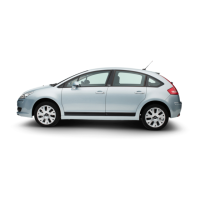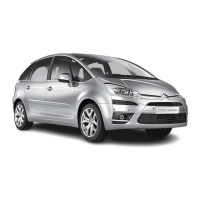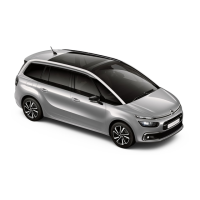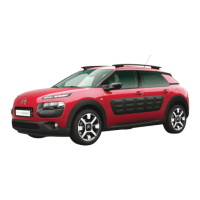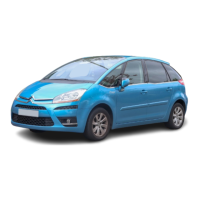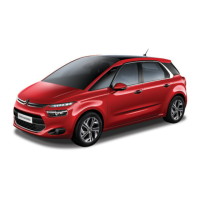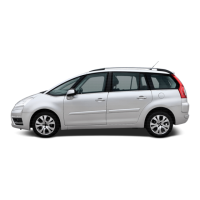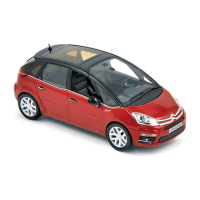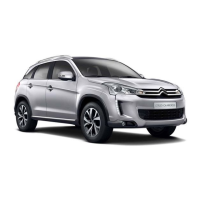
Do you have a question about the CITROEN C4 Aircross 2013 and is the answer not in the manual?
| Brand | CITROEN |
|---|---|
| Model | C4 Aircross 2013 |
| Category | Automobile |
| Language | English |
System for locking, unlocking, and starting the vehicle with the key on your person.
System that temporarily stops the engine during traffic stops to reduce fuel consumption.
Details on using the remote control for unlocking and locking the vehicle.
System for keyless locking, unlocking, and starting the vehicle.
Allows selection of transmission mode based on driving conditions.
Instructions on fastening, unfastening, and adjusting front seat belts.
Explanation of lighting controls including headlamps and sidelamps.
Details on windscreen and rear wiper controls.
Controls for temperature, air flow, and air distribution in manual mode.
Explanation of the rev counter, speedometer, and instrument panel screen.
Explanation of warning lamps that illuminate during ignition and engine running.
Details on deactivating the passenger airbag for child seat safety.
Describes the positions and functions of the ignition switch.
Explains how the START/STOP button changes the vehicle's mode.
Indicates when cruise control is activated.
Indicates operation or faults in stability and traction control systems.
Lists and explains system messages when the ignition is OFF.
Lists and explains system messages when the ignition is ON.
How to check coolant temperature and overheating indicators.
System for central unlocking/locking, guide-me-home lighting, and starting.
Secures the vehicle by making interior/exterior controls inoperative.
System for keyless locking, unlocking, and starting the vehicle.
How to lock and deadlock the vehicle using the electronic key.
Using the integral key for unlocking/locking when the electronic key fails.
Alarm system functions and operation.
Procedure for activating and deactivating the alarm system.
Anti-pinch system for the driver's side window.
Details on manual adjustments for front seats (forwards/backwards, backrest, height).
Adjusting steering wheel for height and reach.
Detailed steps for starting and stopping the engine using the ignition switch.
How to change the vehicle's mode using the START/STOP button.
Procedure for switching off the engine using the electronic key.
Procedure for starting the vehicle when the electronic key is not detected.
Procedure for stopping the engine in an emergency using the electronic key.
How the electronic immobiliser prevents unauthorized starting.
Applying and releasing the parking brake.
Explains the two driving modes (automated/manual) and controls.
Procedure to release the gear lever if it's locked in P.
How the engine goes into standby and associated conditions.
How the engine restarts automatically and special cases.
How to deactivate and reactivate the Stop & Start system.
Selection of transmission modes for different grip conditions.
Specific towing instructions for 4WD vehicles.
Details on activating, programming, and using the cruise control system.
Methods to turn off cruise control manually or automatically.
How to resume cruise control after deactivation.
How rear parking sensors indicate proximity to obstacles via audible signals.
Front parking sensors: detection and warnings.
How the reversing camera system works with the navigation screen.
Stalk for selecting and switching front and rear exterior lamps.
System that automatically corrects headlamp height based on vehicle load.
System for selecting and controlling front and rear wiping modes.
Wipers operate automatically based on detected rain intensity.
ABS and EBFD systems improving stability and maneuverability.
Warning lamps and actions for ABS/EBFD system malfunctions.
Traction and stability control systems.
Front and rear seat belt information.
Pretensioning and force limiting system for front seat belts.
Warnings for unfastened driver's and passenger's seat belts.
Advice on child seat usage and child safety in the vehicle.
Airbag system overview and safety.
System protecting head and chest in front impacts.
How to deactivate the front passenger airbag for child seat safety.
How to reactivate the passenger airbag after child seat removal.
System protecting driver's knees in a front impact.
System protecting chest in side impacts, fitted in seat frames.
System protecting head in side impacts, fitted in pillars.
Recommendations for child seat usage and safety by European regulations.
Installing rearward-facing and forward-facing child seats in the front.
Instructions and warnings for deactivating the passenger airbag.
Installing rearward-facing and forward-facing child seats in rear seats.
Recommended child seats secured by a three-point seat belt.
Table indicating suitable child seat locations based on child weight and seat type.
Description of ISOFIX mountings (rings and Top Tether) for child seat installation.
Recommended ISOFIX child seats and their installation methods.
Table indicating ISOFIX seat installation options by size category.
General advice on correct child seat installation and vehicle safety.
Legislation and safety for children in the front passenger seat.
Complete system for temporary tire repair.
Step-by-step guide for sealing and repairing a tire puncture.
Procedure for changing a wheel, including tools and fitting.
Procedure for identifying, extracting, and replacing fuses.
Procedure for jump-starting the vehicle using another battery.
Instructions for charging the battery with a charger.
Procedure for towing 2WD vehicles with wheels on the ground.
Specific instructions for recovering 4WD vehicles on a flatbed.
Instructions for safely filling the fuel tank.
Procedure for manually priming the fuel system if the engine runs out of diesel.
How to check engine oil, brake fluid, coolant, and screenwash levels.
How to check engine oil level using the dipstick.
How to check brake fluid level and its relation to brake pad wear.
How to check coolant level and safety precautions.
Checking electrolyte level and precautions for battery work.
Warning lamp for filter saturation and regeneration procedure.
When and how to check the parking brake system.
Approved maximum towed weights and load values based on altitude and temperature.
Approved maximum towed weights and load values for diesel vehicles.
Controls for answering, ending calls, and activating voice recognition.
Procedure for creating a voice model for personalized voice recognition.
First connection procedure for pairing a mobile phone with the system.
Details on using the navigation system.
Setting navigation options and selecting destinations.
Controls for temperature, air flow, and air distribution in manual mode.
How the system automatically controls air distribution, flow, and temperature.
Table of error messages for CD and USB/Apple players and their solutions.
Breakdown of navigation menu levels and their functions.
Turn indications, distance, and navigation zoom options.
Instructions for playing audio CDs and MP3/WMA/AAC files.
Connecting and using portable devices via the USB port.
Steps to connect a Bluetooth phone to the car's audio system.

